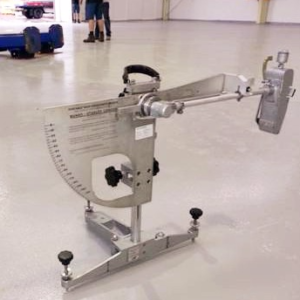Oil-Wet Inclining Ramp test vs Wet Pendulum test

It is not uncommon to find flooring clients confused by the difference in slip resistance ‘R’ and ‘P’ values. In this article we take a closer look at the two most common tests for slip resistance of flooring surfaces as outlined in the AS4586-2013 Australian Standard for Slip Resistance of Flooring Surfaces.
What is an Oil-wet Inclining Ramp Test?
Inclined ramp testing is a way of classifying different levels of slip resistance of a ramp. They are the most common tests for producing slip resistance ratings ‘R’ on new pedestrian surfaces. R9 represents the lowest amount of slip resistance and R13 represents the highest amount of slip resistance.
First standardised in Germany, the Oil-Wet Inclining Ramp Test is used to test surfaces intended for a range of industrial applications, where flooring is predominantly covered in relatively high-viscosity oils and liquids where workers will be wearing profiled safety shoes. This could be in workshops, commercial kitchens or other similar environments.
How is the Oil-Wet ramp test conducted?
Prior to conducting each test, the test surface is coated with oil. Test operators wearing regulated footwear with highly profiled soles begin walking up and down the test surface. The operator then controls the gradual increase in platform angle.
The greater the angle that a person can walk on the ramp without slipping is equal to the slip resistance of the ramp surface. However, this is only a suggestion, and ramps should not be installed at the angle reported in the Oil-Wet test. Always refer back to Standards Australia Handbook 197, An introductory guide to the slip resistance of pedestrian surface materials when installing flooring materials.

What is the Wet Pendulum test?
The Wet Pendulum test is another way of determining slip resistance of a surface, and is typically used on hard or resilient floor coverings. It is inexpensive and carried out in wet conditions unless the flooring is an internal textile (in which case, this test is carried out dry).
Because the Wet Pendulum test can be carried out either during manufacturing or installation, this test has become popular as a result of its practicality and flexibility.
How is the Wet Pendulum test conducted?
The Wet Pendulum test involves a pendulum slider instrument that is used to make contact with the test surface over a prescribed distance. The quantity of resistance (P) to the motion of the pendulum is measured. The contact surface of the slider material is prepared to a consistent level of smoothness prior to each group of tests.
The following table shows the classification given to surfaces in ‘P’ value once the test has been completed. These values are documented within the AS4586-2013 Australian Standard for Slip Resistance of Flooring Surfaces.
There are two types of rubber sliders that can be used in a Wet Pendulum Test, and the table shows specific values for each.
| Classification of pedestrian surface materials according to the AS4586-2013 Wet pendulum test. | ||
| Classification | Wet pendulum SRV (slip resistance values) | |
| Slider 96 rubber* | Slider 55 rubber** | |
| P5 | >54 | >44 |
| P4 | 45-54 | 40-44 |
| P3 | 35-44 | 35-39 |
| P2 | 25-34 | 20-34 |
| P1 | 12-24 | <20 |
| P0 | <12 | |
*A slider 96 rubber can be used on all surfaces, however is best suited to rough surfaces as they are made from a harder rubber.
**A slider 55 rubber is used for surfaces of relatively high slip resistance. They are made from a softer rubber and provide relatively good discriminations.
What rating do I need for my surface?
The following table shows the ratings required depending on the surface as per the safety requirements outlined in the National Construction Code (NCC).
The NCC incorporates the on-site construction requirements of the Building Code of Australia (BCA) Volumes 1 and 2, and the Plumbing Code of Australia (PCA) into a single code. The NCC however, is limited to only a certain number of applications within buildings such as stair treads, stair nosings and some ramps. Because of this, it cannot be considered as providing a slip-safe environment in all situations.
| Minimum wet pendulum test or oil-wet inclining platform classifications that are deemed to satisfy the building applications in the national construction code (NCC). | ||
| Location | Wet pendulum test | Oil-wet inclining platform test |
| Stair Treads and stairway landings in buildings covered by NCC volumes one and two: | ||
| Stair treads and a stairway landing (when dry) | P3 | R10 |
| Stair treads and a stairway landing (when wet) | P4 | R11 |
| Nosings for stair treads and stairway landings in building covered by NCC volumes one and two: | ||
| Dry stair tread, a stair non-skid nosing strip and a stairway landing | P3 | |
| Wet stair tread, a stair non-kid nosing strip and a stairway landing | P4 | |
| Ramps in buildings covered by NCC volume one and two: | ||
| Ramps not steeper than 1:14 gradient (when dry) | P3 | R10 |
| Ramps not steeper than 1:14 gradient (when wet) | P4 | R11 |
| Ramps not steeper than 1:14 up but not steeper than 1:8 (when dry) | P4 | R11 |
| Ramps steeper than 1:14 up but not steeper than 1:8 (when wet) | P5 | R12 |
